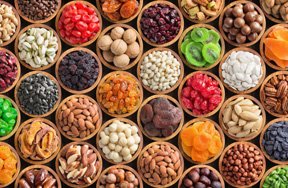You know what blood is: it's that red stuff that oozes out if you get a cut. The average person has about 1 to 1.5 gallons (4-6 liters) of it. But what is blood, really, and where does it come from?
Your Body & Blood
Like any good recipe, blood has ingredients. To make blood, your body needs to mix red blood cells (which carry oxygen throughout the body), white blood cells (which fight infections), platelets (which are cells that help you stop bleeding if you get a cut) and plasma (a yellowish liquid that carries nutrients, hormones and proteins throughout the body) – all of which your body makes itself. Bone marrow – that goopy stuff inside your bones – makes the red blood cells, the white blood cells and the platelets. Plasma is mostly water, which is absorbed from the intestines from what you drink and eat, with the liver supplying important proteins.
Put all these ingredients together and you have blood – an essential part of the circulatory system. Thanks to your heart (which pumps blood) and your blood vessels (which carry it), blood travels throughout your body from your head to your toes.
Red Blood Cells

Red blood cells (also called erythrocytes) look like flat basketballs. Most of the cells in the blood are red blood cells. They carry around an important chemical called hemoglobin that gives blood its red color and delivers oxygen, which you get from the air you breathe, to all parts of your body.
White Blood Cells

White blood cells (also called leukocytes) are bigger than red blood cells. There are usually not a whole lot of white blood cells floating around in your blood when you're healthy. Once you get sick, though, your body makes some more to protect you.
There are a couple types of white blood cells that do different things to keep you well. Granulocytes have a lot to do with how your body cleans things up and helps wounds heal after an injury. They also help prevent infection by surrounding and destroying things that aren't supposed to be in your body and by killing germs. Lymphocytes come in two types; B cells help make special proteins called antibodies that recognize stuff that shouldn't be in your body, like bacteria or a virus you get from a sick friend. T cells also battle germs that invade the body, but instead of making antibodies, they work by making special chemicals that help fight the infection. And Monocytes are white blood cells that fight infection by surrounding and destroying bacteria and viruses.
Platelets

Platelets are tiny round cells that help to make sure you don't bleed too much once you get a cut or scrape. Cuts and scrapes break blood vessels. If a platelet reaches a blood vessel that's been broken open, it sends out a chemical signal that makes other nearby platelets start to stick together inside the vessel. After the platelets form this plug, they send out more chemical signals that attract clotting factors. These clotting factors work together to make a web of tiny protein threads. The platelets and this web of protein come together to make a blood clot. The clot keeps your blood inside the vessel while the break in the blood vessel heals up. Without platelets, you'd need more than a bandage to catch the blood when you scrape your knee!
Plasma

Plasma is a yellowish liquid that is mostly water. But it also carries important nutrients, hormones and proteins throughout the body. Plasma also carries away cell waste: chemicals that the cell doesn't want anymore. Nutrients, hormones, proteins and waste are dissolved in the plasma and blood cells float in the plasma.
What's Your Type?
Sure, everybody's blood is red, but it's not all the same. There are eight blood types, described using the letters A, B and O, which stand for certain proteins found on the red blood cells. Not everyone has the same proteins. Plus, every person’s blood is either positive or negative to help keep track of whether someone's blood has a certain protein called Rh protein. If your blood is positive, you have this protein. If it's negative, you don't. Either way is totally fine.
People have one of these eight different blood types:
- A negative
- A positive
- B negative
- B positive
- O negative
- O positive
- AB negative
- AB positive
Blood types are important if a person ever wants to donate blood or needs a blood transfusion. Getting blood of the wrong type can make a person sick. That's why hospitals and blood banks are very careful with donated blood and make sure the person gets the right type. People might need blood transfusions when they're sick or if they lose blood. Without enough healthy blood, the body won't get the oxygen and energy it needs. Healthy blood also protects you from germs and other invaders.
The Truth About Transfusions

Every year, more than 4 million American kids and adults receive blood transfusions. In fact, blood transfusions help save lives each day! But what is a transfusion and why would someone need one? A blood transfusion is a way of giving one person's blood to someone else who needs it. When you need blood, you really need it because your body won't work right without enough healthy blood.
Blood transfusions are possible because volunteers donate their blood. That makes it available at hospitals. It may sound creepy to donate blood, but it's safe and no big deal for a healthy person to donate a small amount – usually 1 pint (473 milliliters). Your mom or dad might have done this. Kids don't usually donate blood, but it's a good thing to do when you're older.
People who have certain illnesses such as hepatitis or HIV infection aren't allowed to donate blood, because they could pass their sickness on to another person through a blood transfusion. After blood is collected, blood banks test it very carefully to make sure the blood is free of diseases and germs. The blood bank, where donated blood is kept, discards any blood that could make someone sick.
Blood banks are also very careful not to contaminate stuff like needles. People who collect the blood are sure to use a new needle and fresh collection equipment for every donor. That way, even if someone's blood was infected, it can't be spread to other people or contaminate other healthy blood at the blood bank.
Why Transfusions?
Transfusions are often needed to save the lives of kids and adults who have life-threatening medical problems. A person might need blood if they've been in a bad accident, had surgery that caused blood loss, or have a certain disease, such as cancer or sickle cell anemia. Little babies that are born too early also might need transfusions to stay healthy while they grow.
Hospitals have to be careful when they give a blood transfusion. People have different blood types, and not all blood will work in all people. Do you know your blood type? Your mom or dad might. But don't worry if no one knows. If you ever need blood, the hospital would very quickly find out your blood type and may even do additional tests to make sure you get the right kind of blood. The blood will be tested against your blood before it is given to make sure it is compatible with your blood.
Transfusions can be done very quickly, if necessary, like in an emergency situation. But when it's not an emergency, the transfusion can happen more slowly, taking a few hours to finish. When the transfusion's done, the person has taken a big step toward being healthy and feeling good again.






























